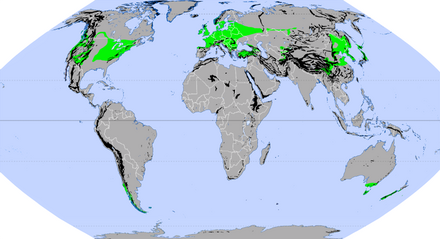Damp middle widths
The wet middle latitude zone is one of the nine global eco-zones according to J. Schultz. Today it occupies about 9.7% of the earth's land surface. At the beginning of the 21st century, around 15% of this is still in a largely natural state .
It occupies the areas in the cool temperate climate zone , which have a humid climate . According to the predominant vegetation, it can be further subdivided into the landscape types temperate rainforest , mixed forest , mountain coniferous forest , summer green deciduous forest and forest steppe .
The limits of the moist middle widths are in reality fluid, so that an exact extent - as shown on the map - can in fact not be determined. This fact becomes understandable if one uses comparable geozonal models , e.g. T. have significant deviations. For example, consider the comparable nemoral zonobiom on the map of the zonobiome according to Walter and Breckle or the FAO Ecozones .
Individual evidence
- ↑ Schultz, J. (2008): The Earth's Eco Zones . Stuttgart: Ulmer. ISBN 978-3-8252-1514-9
- ↑ Values from J. Schultz (Schultz, J. (2008): Die Ökozonen der Erde. Stuttgart) without Antarctica and Greenland converted to the entire land surface. See the article Eco zone # The individual eco zones . (See also tabular overview of various landscape zone models and their proportions ; PDF; 114 kB)
- ↑ Map data for the studies "Last of the wild", "Intact forest landscapes" and "Review of status and conservation of wild land in Europe", summarized in the source description for the "Wilderness World Map" on Wikimedia Commons
literature
- J. Schultz: The Earth's Eco Zones. Ulmer, Stuttgart 2016 (5th edition) ISBN 978-3-8252-4628-0
- J. Pfadenhauer, F. Kötzli: Vegetation of the earth. Springer Spectrum, Heidelberg 2014. ISBN 978-3-642-41949-2 .
- W. Zech, P. Schad, G. Hintermaier-Erhard: Soils of the world. 2nd Edition. Springer Spectrum, Heidelberg 2014. ISBN 978-3-642-36574-4 .
